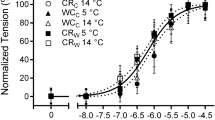Abstract
Experimental data are available for the oxygen cost of the branchial and cardiac pumps in fish. These data were used to theoretically analyze the relative oxygen cost of these pumps during rest and swimming in rainbow troutSalmo gairdneri. Efficiency of the heart increases with activity and so the relative oxygen cost of the cardiac pumps decreased from 4.6% at rest to 1.9% at the critical swimming speed. The relative oxygen cost of the branchial pump is significant in the resting and slowly swimming fish, being 10 to 15% of total oxygen uptake. However, when swimming trout switch to a ram mode of ventilation, a considerable saving in oxygen cost is accrued by switching the cost of ventilation from the branchial to the tail musculature. Thus, the relative oxygen cost of the branchial and cardiac pumps actually decreases at critical swimming speed compared to rest and therefore is unlikely to be a major limiting factor in maximum oxygen delivery to the tissues.
Similar content being viewed by others
References cited
Brown, C.E. and Muir, B.S. 1970. Analysis of ram ventilation of fish gills with application to skipjack tuna (katsuwomus Pelamis). J. Fish. Res. Bd. Can. 21: 1183–1225.
Bushnell, P.G., Steffensen, J.I. and Johansen, K. 1984. Oxygen consumption and swimming performance in hypoxia-acclimated rainbow trout,Salmo gairdnri. J. Exp. Biol. 113: 225–235.
Cameron, J.N. and Cech, J.J.Jr. 1970. Notes on the energy cost of gill ventilation in teleosts. Comp. Biochem. Physiol. 34: 447–455.
Daxbocck, C., (1982. Effect of coronary ablation on exercise performance inSalmo gairdneri. Can. J. Zool. 60: 375–381.
Farrell, A.P. 1984. A review of cardiac performance in the teleost heart: intrinsic and humoral regulation. Can. J. Zool. 62: 523–536.
Larrell, A.P. 1985. Cardiovascular and heamodynamic energetics of fishes.In Circulation, Respiration and Metabolism. pp 377–385. Edited by R. Gilles. Springer-Verlag. Berlin, Heidelberg.
Farrell, A.P., Macl cod, K.R. and Chancey, B. 1986. Intrinsic mechanical properties of the perfused rainbow trout heart and the effects ol catecholamines and extracellular calcium under control and acidotic conditions. J. Exp. Biol. 125: 319–345.
Farrell, A.P. and Milligan, C.I. 1986. Myocardial intracellular pH in a perfused rainbow trout heart during extracellularacidosis in the presence and absence of adrenaline. J. Exp. Biol. 125: 347–359.
Farrell, A.P. and Sleffensen, J.F. 1987. Coronary ligation reduces maximum sustained swimming speed in chinook salmon.Oncorhynchus tshawytscha. Comp. Biochem. Physiol. (In press).
Farrell, A.P., Wood, S., Hart, I. and Driedzic, W.R. 1985. Myocardial oxygen consumption in the sea raven.Hemitriplerus americanus: the effects of volume loading. pressure loading and progressive hypoxia. J. Exp. Biol. 117: 237–250.
Freadman, M.A. 1979. Swimming energetics of striped bass (Morone saxatilis) and bluefish (Pomatomus saltatrix): Gill ventilation and swimming metabolism. J. Exp. Biol. 83: 217–230.
Freadman, M.A. 1981. Swimming energetics of striped bass (Morone saxatilis) and bluefish (Pomatomus saltatrix): Hydrodynamic correlates of locomotion and gill ventilation. J. Exp. Biol. 90: 253–265.
Gibbs, C.I. and Chapman, J.B. 1979. Cardiac energetics.In Handbook ol Physiology. Vol. 1, Section 2. pp 775–804. Edited by Berne, R.M. American Physiological Society, Bethesda, Maryland.
Holeton, G.F. 1980. Oxygen as an environmental factor of fishes.In Environmental Physiology of Fishes. NATO ASI. pp 7–32. Edited by M.A. Ali. Plenum Press. New York.
Jones, D.R. 1971a. Theoretical analysis of factors which may limit the maximum oxygen uptake of fish: The oxygen cost of the cardiac and branchial pumps. J. Theor. Biol. 32: 341–349.
Jones, D.R. 1971b. The effect of hypoxia and anemia on swimming performance of rainbow trout (Salmo gairdneri). J. Exp. Biol. 55: 541–551.
Jones, D.R. and Schwarzfeld, I. 1974. The oxygen cost to the metabolism and efficiency or breathing in trout (Salmo gairdneri). Respir. Phvsiol. 21: 241–254.
Jones, D.R. and Randall, D.J. 1978. The respiratory and circulatorv svstems during exercise.In Fish Physiology, pp. 425–501. Edited by W.S. Hoar and D.J. Randall. Academic Press, New York.
Kiceniuk, J.W. and Jones, D.R. 1977. The oxygen transport system in trout (Salmo gairdneri during sustained exercise. J. Exp. Biol. 69: 247–260.
Necly, J.R., Iiebermeister, H., Battersby, F.I. and Morgan, H.E. 1967. Effects of pressure development on oxygen consumption by isolated rat heart. Am. J. Physiol. 212: 804–814.
Roberts, J.L. 1978. Ram ventilation in fish.In The Physiological Ecology of Tunas. pp 83–88. Edited by G.D. Sharp and A.E. Dizon. Academic Press, New York.
Sleffensen, J.F. 1985. The transformation between branchial pumping and ram ventilation in fishes: Energetic consequences and dependence on water oxygen tension. J. Exp. Biol. 114: 141–150.
Sleffensen, J.F. and Lomholt, J.P. 1983. Lnergetic cost of active branchial ventilation in the sharksucker.Echeneis nauarates. J Exp. Biol. 103: 185–192.
Suga, H., Hayashi, T., Shirahata, M., Suehire, S. and Hisano, R. 1981. Regression of cardiac oxygen consumption on ventricular pressure-volume area in dog. Am. J. Physiol. 240: 320–325.
Suga, H., Hisano, R., Hirata, S., Hayashi, T. and Nonomiyall. 1982. Mechanism of higher oxygen consumption rate: pressure-loaded vs. volume-loaded heart. Ám. J. Physiol. 242: 942–948.
Van Dam, I., 1938. On the utilization of oxygen and regulation of breathing in some aquatic animals. Ph.D. dissertation. Groningen University. Holland.
Wood, C.M., Pieprzak, P. and Trott, J.N. 1979. The influence of temperature and anemia on the adrenergic and cholinergic mechanisms controlling heart rate in the rainbow trout. Can. J. Zool. 57: 2440–2447.
Author information
Authors and Affiliations
Rights and permissions
About this article
Cite this article
Farrell, A.P., Steffensen, J.F. An analysis of the energetic cost of the branchial and cardiac pumps during sustained swimming in trout. Fish Physiol Biochem 4, 73–79 (1987). https://doi.org/10.1007/BF02044316
Issue Date:
DOI: https://doi.org/10.1007/BF02044316




